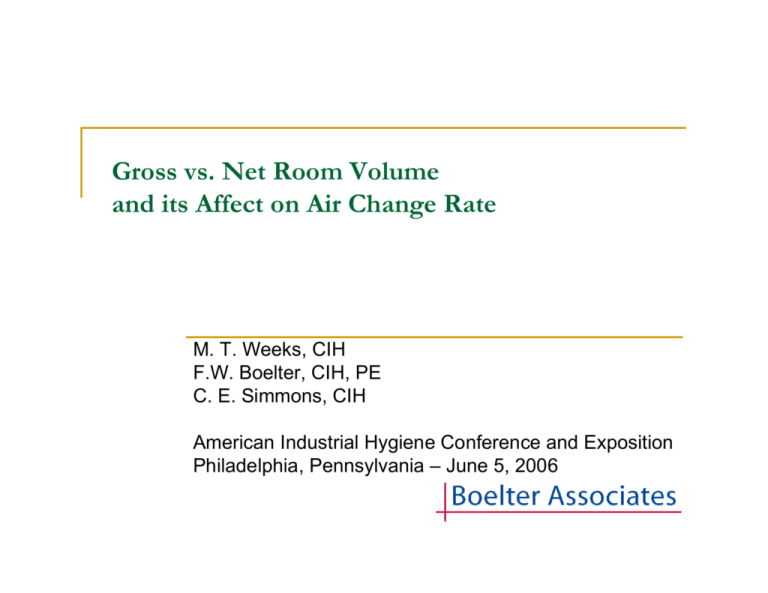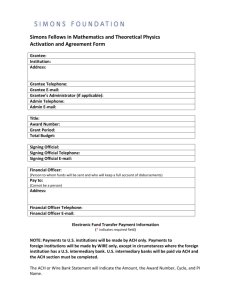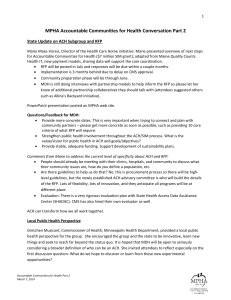Air Change Rate: Gross vs. Net Room Volume Impact
advertisement

Gross vs. Net Room Volume and its Affect on Air Change Rate M. T. Weeks, CIH F.W. Boelter, CIH, PE C. E. Simmons, CIH American Industrial Hygiene Conference and Exposition Philadelphia, Pennsylvania – June 5, 2006 Introduction ASTM Method E741 is a standardized method used to measure the air change rate of a single-zone space using a tracer gas Using this method, the volume of the space is not a factor in determining air change rate Other methods for determining air change rate require the estimation of the volume of the space How important is it to accurately estimate room volume when calculating air change rate for a space? Air Change Rate – ASTM E741 Standard Test Method for Determining Air Change in a Single Zone by Means of a Tracer Gas Dilution (2000) Allows direct measurement of air change rate Concentration Decay Method used Background measurements taken Tracer gas introduced Uniform concentration established Concentration measured over time Linear regression performed; air change rate is equal to slope of regression line ASTM Method E741-00, Standard Test Method for Determining Air Change in a Single Zone by Means of a Tracer Gas Dilution. American Society of Testing and Materials, 2000. Sulfur Hexafluoride Concentration vs. Time Inside Test Chamber During Test 30 Concentration SF6 (ppm) 25 20 15 10 5 0 10:54 11:53 12:53 13:53 14:53 15:53 Time Air Changes per Hour = 0.1 16:53 17:53 18:52 Air Change Rate - Traditional Volume of room determined – length x width x height Volume of air coming into and leaving room is determined Using measurements (e.g., air velocity) Using other available information (e.g., fan cfm) Simple calculation e.g.: Q (cfm) x 60 = Air changes per hour V of room (ft3) Occupied Space Room space can be occupied by: Production equipment or machinery Ductwork Piping Office or other furniture Other work settings may present different objects Bench equipment at a laboratory hood or other similar workstation Our Study Fourteen tests performed in a test chamber (20’ x 20’ x 9’ = 3600 ft3) Air machines set to move 0, 2, 6, and 10 air changes per hour of total (i.e., unoccupied) room V Air change rates determined using: ASTM method E741-00 (tracer gas) Calculation based on velocity of ventilated air Volume of space occupied at 0%, 10%, and 25% Air mechanically mixed using box fans Equipment Tracer gas – sulfur hexafluoride (SF6) Innova 1412 Multi-Gas Monitor Extremely low background levels (10-20 ppb) Easily detectable with proper equipment Non-toxic (PEL = 1000 ppm) and inert Measures SF6 at ppb level Occupied space – 4’ x 4’ x 8’ boxes (128 ft3) Two air machines – approx. 600 cfm Air Change Rates Measured – ASTM E741 Calculated – Air Change Rate = Q*60/V Total Room Volume of 3600 ft3 (VT) Effective Room Volume after occupying space (Veff) Q calculated using velocity measurements of exhausted air Expected ACH values were calculated based on tracer gas result with no occupied space and change in room volume Results – No Occupied Space Target Air Change Rate 0 ACH Measured ACH – Tracer Gas 0.3 Calculated ACH – VT (3600 ft3) 0 Calculated ACH – Veff (3600 ft3) 0 2 ACH 0.9 2.3 2.3 6 ACH 5.0 6.0 6.0 10 ACH 7.7 10.4 10.4 Results – 10% Occupied Space Target Air Change Rate 2 ACH 6 ACH 10 ACH Expected ACH Value 1.0 5.6 8.6 Measured ACH – Tracer Gas Calculated ACH – VT (3600 ft3) Calculated ACH – Veff (3216 ft3) 1.0 2.0 2.2 0.7 2.0 2.2 1.1 2.0 2.2 5.5 6.1 6.8 8.3 9.9 11.1 9.3 9.9 11.1 7.8 9.9 11.1 Results – 25% Occupied Space Target Air Change Rate Expected ACH Value Measured ACH – Tracer Gas Calculated ACH – VT (3600 ft3) Calculated ACH – Veff (2576 ft3) 0 ACH 0.4 0.05 0 0 2 ACH 1.2 1.2 2.2 3.1 10 ACH 10.8 11.5 9.9 14.1 Conclusions Tracer gas air change rates mirrored expected values for changing volumes (average difference 9%), so Veff does affect air change rate Calculated air change rates ignoring volume change 56% above expected values Calculated air change rates accounting for volume change 82% above expected values Using Veff to calculate air change rate produced 1042% higher result than using VT, increasing with amount of occupied space Recommendations In all cases, direct measurement of air change rate using a tracer gas method provides most accurate results When calculating air change rate for a space, taking effective volume into consideration will have a significant effect on your result Using the effective volume of a space may or may not bring you closer to the truth – professional judgment should be used When modeling, consider your method of calculating air change rates very carefully Gross vs. Net Room Volume and its Affect on Air Change Rate Thank you! Michael Weeks, CIH Boelter Associates, Inc. Park Ridge, Illinois (847) 692-4700 mweeks@boelterassociates.com www.boelterassociates.com




